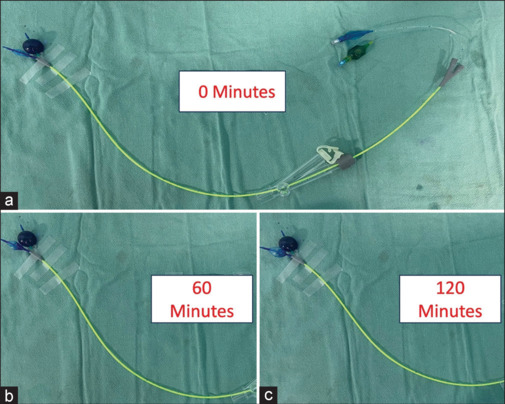Dear Editor,
Lung isolation is a standard procedure performed in patients undergoing lung surgery. Bronchial blockers constitute an established method for lung isolation.[1] EZ-Blocker® is one of the bronchial blockers available, and we report a rare but significant complication associated with its use.
A 75-year-old male patient was posted for a right lower lobectomy. The anaesthetic plan was general anaesthesia with a thoracic epidural analgesia. The trachea was intubated with an 8.5-mm ID single-lumen cuffed endotracheal tube. A 7Fr EZ-Blocker® (Rusch, Teleflex Life Sciences Limited, Ireland) was placed for right lung isolation under fibre-optic bronchoscopic guidance (size 2.8 Fr; Karl Storz, Germany). Before insertion, the cuffs were tested for air leaks. The bronchial blocker was advanced until the Y-shaped distal end was stranded on the carina, confirming that one extension had been positioned in each bronchus. The right bronchial cuff was inflated with air, and the minimal occlusion volume (12 mL) to obliterate the lumen was noted under bronchoscopic visualisation. Auscultation and lung ultrasound were performed to confirm lung isolation. Pressure-controlled ventilation was initiated for single-lung ventilation, and surgery started. After 45 minutes into the surgery, the tidal volume and minute ventilation decreased while end-tidal carbon dioxide gradually increased, and the surgeon noticed that the non-dependent lung was being ventilated. While checking, we observed that the pilot balloon of the left bronchial cuff had spontaneously inflated, and the other pilot balloon appeared to have lost volume. Subsequently, 5 mL of air was aspirated from the left cuff to deflate it completely. This improved the ventilation; however, the non-dependant lung was still getting ventilated. We injected 5 mL of air into the right cuff, and this manoeuvre now isolated the non-dependent lung. We had to repeat this process of removing and replacing the air from the left cuff to the right cuff a few times throughout the surgery (4.5 hours) whenever tidal volume and minute ventilation dropped. After the procedure, the EZ-Blocker® was taken out and inspected. No damage was noted externally. After the procedure, methylene blue was used to check for internal leaks. One of the cuffs (yellow) was insufflated with 12 mL of methylene blue-tinged saline and left for observation, while the other (blue) cuff was completely deflated. Figure 1a shows the cuffs at 0 minutes, while Figures 1b and c show that the blue cuff started filling spontaneously after 60 minutes and continued to inflate at 120 minutes.
Figure 1.

Spontaneous inflation of deflated cuff at time frames: 0 minutes (a), 60 minutes (b), and 120 minutes (c)
Dillemans et al.[2] reported similar complication in four patients. However, they, too, could not identify the site of the leak. Dillemans et al. observed varying time lags (9–30 minutes) for presentation in their patients.[2] Based on Dillemans et al.'s report, Bouchez et al. attempted to locate the bronchial cuff line leak by injecting contrast in one cuff and saline in another and viewing it under a computed tomography scan. They, too, could not identify the connection.[3]
Declaration of patient consent
The authors certify that they have obtained all appropriate patient consent forms. In the form, the patient consented to his images and other clinical information to be reported in the journal. The patient understands that his name and initials will not be published and due efforts will be made to conceal his identity, but anonymity cannot be guaranteed.
Financial support and sponsorship
Nil.
Conflicts of interest
There are no conflicts of interest.
REFERENCES
- 1.Moritz A, Irouschek A, Birkholz T, Prottengeier J, Sirbu H, Schmidt J. The EZ-blocker for one-lung ventilation in patients undergoing thoracic surgery: Clinical applications and experience in 100 cases in a routine clinical setting. J Cardiothorac Surg. 2018;13:77. doi: 10.1186/s13019-018-0767-9. doi: 10.1186/s13019-018-0767-9. [DOI] [PMC free article] [PubMed] [Google Scholar]
- 2.Dillemans J, Van Gompel C, Wouters P, Vanpeteghem C. Technical failure of the EZ-blocker™ causing serious adverse events during one lung ventilation: A case series. Anaesth Rep. 2022;10:e12160. doi: 10.1002/anr3.12160. doi: 10.1002/anr3.12160. [DOI] [PMC free article] [PubMed] [Google Scholar]
- 3.Bouchez S, Aerts P, De Somer F, Foubert L. Computed tomography confirmation of an interluminal connection in the Rüsch EZ-blocker™. Anaesth Rep. 2023;11:e12206. doi: 10.1002/anr3.12206. doi: 10.1002/anr3.12206. [DOI] [PMC free article] [PubMed] [Google Scholar]


